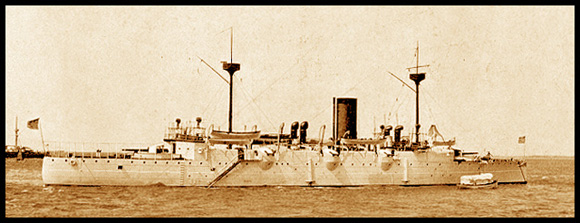


CHARLESTON's first duty was to join the South Pacific squadron as flagship. Later, she had the honor of carrying the body of the Hawaiian King Kalakaua back to Hawaii when he died abroad. In 1891, when tensions ran high during a revolution by British-backed rebels against the U.S.-backed government of Chile, the Chilean steamship ITATA left San Diego, California apparently to take supplies to the Chilean rebels. The American government ordered an extensive search for the vessel in which the CHARLESTON took a conspicuous part. The ITATA eventually steamed into Chile without being intercepted. The U.S. demanded that the ship and her contents be turned over to the U.S., an action that the CHARLESTON's Captain Remey stated made the U.S. and her navy "very unpopular with the Insurgents on account of our action." The Insurgents won the rebellion, and the anti-American feeling which the CHARLESTON's commander spoke about boiled over when the crew of Winfield Scott Schley's BALTIMORE went ashore. Two crewmen were killed and a score others wounded.
In the latter part of 1891, CHARLESTON was assigned as flagship of the Asiatic Squadron, however during most of 1892 she was again serving with the South Pacific Squadron.
In February of 1893, CHARLESTON arrived in Hampton Roads, Virginia. About a month and a half later, she took part in the International Naval Review at the Columbian Exposition. From 1893 to 1896, CHARLESTON steamed around the coasts of South America, and eventually returned to the Asiatic Squadron. The CHARLESTON returned to the United States in July of 1896, and was decommissioned at San Francisco.
When the Spanish American War broke out, CHARLESTON was hastily recommissioned on May 5, 1898. She was ordered to convoy the transports CITY OF PEKING, CITY OF SIDNEY, and the AUSTRALIA, containing 2,500 troops, destined for the Philippines. In addition, the CHARLESTON and her charges carried a new supply of ammunition for Dewey's understocked magazines; a new gun to replace one of the BALTIMORE's , which had been damaged; and sixty-seven additional navy crewmen. On its way across the Pacific, the small squadron stopped at Hawaii, where it was greeted with huge celebrations. The visited helped to further the efforts to have the small island nation annexed by the United States.
CHARLESTON's next stop on her trip across the vast Pacific was less friendly, but sadly comical. She had been ordered to capture Guam from Spain. The invasion required little effort since Spain had neglected to inform her outpost on the small island that the U.S. and Spain were at war. Charleston captured the island without any bloodshed.
CHARLESTON arrived in Manila Bay on June 30, 1898, almost to months after the Battle of Manila Bay. As the CHARLESTON and her small squadron approached, there was concern and speculation among the crews of Dewey's ship as they did not know if it was an American or a Spanish squadron that was approaching. The arrival f the squadron was the catalyst for extensive cheering all around. CHARLESTON joined in maintaining the blockade of Manila Bay.
On August 13, Dewey's squadron prepared for action against Manila, with the CHARLESTON taking up position to bombard the city's Luneta Battery, should it become necessary. After a few token shots from the assembled squadron, Manila surrendered by a pre-arranged signal.
Following the conclusion of the Spanish American War, CHARLESTON remained in the Philippines and was involved in actions against the Filipino Insurgents. She took part in joint operations with the U.S. Army, and also in the Subic Bay expedition, which resulted in the capture of that strategic deep water harbor.
On November 2, 1899, CHARLESTON ran aground on a reef near Camiguin
Island, north of Luzon. She was a total loss. Her crew managed to escape
to a nearby island, where they remained until being picked up by the
HELENA on November 12, 1899.
| Classification: | Protected Cruiser C-2 | ||
|---|---|---|---|
| Laid down: | January 20, 1887 | ||
| Launched: | July 19, 1888 | ||
| Commissioned: | December 26, 1889 | ||
| Rig: | Two masted schooner | ||
| Armament: | Two 8 inch breechloading guns | ||
| Six 6 inch breechloading guns | |||
| Four 6 pounder rapid fire guns | |||
| Two 3 pounder rapid fire guns | |||
| Two 1 pounder rapid fire guns | |||
| Two Colt revolving Guns | |||
| One field piece (for landing parties) | |||
| Contractor: | Union Iron Works, San Francisco, CA. | ||
| Length: | 312 feet, 7 inches | ||
| Beam: | 46 feet, 2 inches | ||
| Draft: | 18 feet, 7 inches | ||
| Maximum draft fully loaded: | 21 feet, 8 1/2 inches | ||
| Displacement | 3,730 tons | ||
| Compliment: | 20 Officers and 286 Enlisted Men under the command of Capt. Henry Glass | ||
| Engine Type: | Twin screw, horizontal compound engines generating 6,666 hp.. | ||
| Speed: | 18.2 knots | ||
| Coal bunker capacity: | 757.70 tons | ||
| Normal coal supply: | 328 tons | ||
| Armor: | 3 inches on slopes and 2 inches on flats. | ||
| Cost: | Cost: $1,017,000 (for hull and machinery). |
Dewey, George, Autobiography of George Dewey (Annapolis: Naval Institute Press, 1987, originally published in 1913 by Charles Scribner's Sons, New York) ISBN 0-87021-028-9.
Goldberg, Joyce, The Baltimore Affair. (Lincoln: University of Nebraska Press, 1986).
Naval History Department, Department of the Navy, Dictionary of American Naval Fighting Ships, Vol. 2, Washington DC: Government Printing Office, 1963.
Young, Louis Stanley, ed., The Bounding Billow, June 1898. (OLYMPIA's ship newspaper).